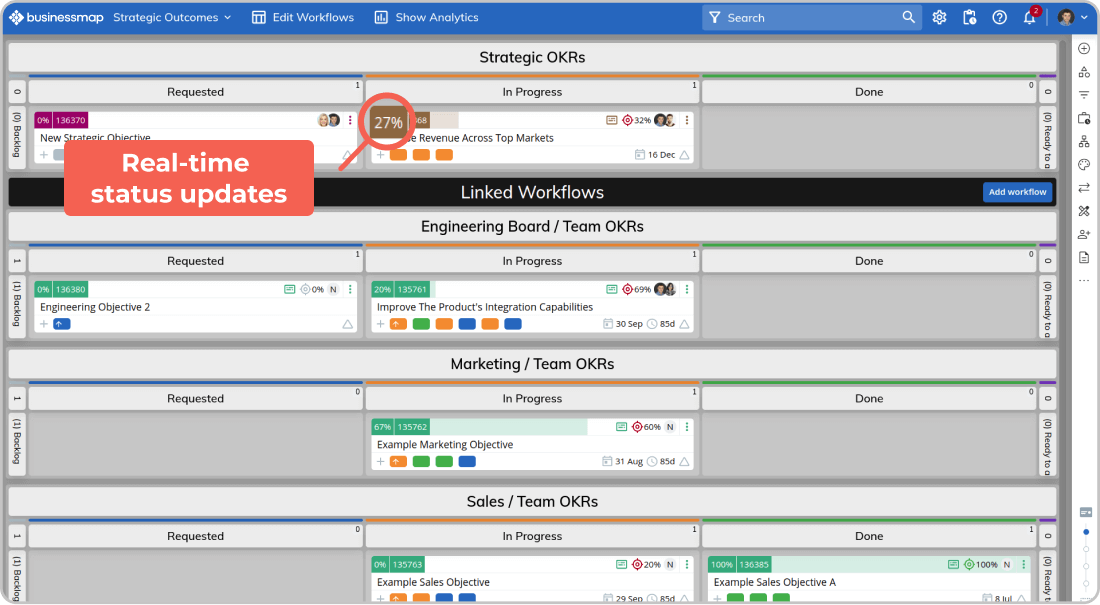CEOs today have a lot on their plates. Balancing AI transformation, sustainability goals, and traditional growth strategies can feel like trying to juggle chainsaws. A big question is: How can you tackle these competing priorities without dropping the ball? The answer might lie in strategic initiatives.
Let's break down what strategic initiatives are, why they're crucial for your business, and how to create ones that will drive your success.
What Are Strategic Initiatives?
Strategic initiatives are specific actions designed to achieve an organization's strategic goals. They are crucial for success and require careful planning and execution. These initiatives should be:
- Clear and measurable: Define specific goals and success metrics.
- Action-oriented: Outline specific steps and timelines.
- Proactive: Anticipate and respond to market changes.
- Aligned with overall strategy: Contribute to the organization's long-term vision.
Strategic initiatives are like your superhero's ultimate moves - the big, bold actions you take to achieve your most important goals.
They're different from your everyday tasks because they have a wider scope and a bigger impact. Think of them as game-changers that will propel your business toward long-term success.
What Makes Strategic Initiatives Critical to Success?
Strategic initiatives can drive and facilitate:
» Laser Focus: They help you stay sharp by focusing your entire team's energy on the most critical goals.
» Breakthrough Results: Strategic initiatives are designed to deliver big wins. They're the kind of projects that move the needle and get everyone excited.
» Future-Proofing: The business world is constantly changing, and strategic initiatives help you stay ahead of the curve. They allow you to adapt to new challenges and emerging opportunities.
So, how do you know if something qualifies as a strategic initiative? Here's a simple rule of thumb: If it's not going to make a significant difference to your company's future, it's probably not a strategic initiative.

Types of Strategic Initiatives
Renowned for his expertise in IT and technology-driven strategic planning, Bernard H. Boar has classified strategic initiatives into five key categories:
- Build-and-Create Initiatives: These initiatives focus on innovation and growth by developing new capabilities, products, or services. They are essential for staying ahead of the competition and capturing new market opportunities.
- Defensive Initiatives: Designed to safeguard existing assets and market positions, defensive initiatives are crucial for maintaining competitiveness and protecting against threats.
- Offensive Initiatives: These initiatives aim to gain a competitive edge or increase market share. They often involve aggressive strategies to outperform rivals.
- Fix-and-Prune Initiatives: Focused on addressing performance gaps and optimizing resources, these initiatives involve correcting issues, restructuring operations, or discontinuing underperforming assets.
- Time-Based Initiatives: Driven by specific deadlines or market windows, time-based initiatives require swift execution to capitalize on opportunities or mitigate risks.
Let's look at some practical examples.
Strategic Initiatives Examples
Here's how strategic initiatives look in business today:
- Digital Transformation: Digital transformation means adopting digital technologies to change how a company operates and delivers value. Examples include AI, cloud computing, process automation, and digital customer engagement. Organizations must also ensure secure AI practices to protect data and maintain trust.
- Operational Excellence: Initiatives focused on improving efficiency, reducing costs, and optimizing operations. For instance, Lean Six Sigma projects, supply chain optimization, process reengineering, and enhancing productivity through better resource management.
- Customer Experience Enhancement: Projects aimed at improving customer satisfaction and loyalty by understanding and addressing customer needs more effectively such as implementing customer feedback systems, improving user interface design, launching loyalty programs, or enhancing service quality.
- Innovation and New Product Development: Initiatives that drive the creation of new products, services, or business models. Strategic initiatives in innovation include R&D projects, launching new products, developing disruptive technologies, or entering new markets.
- Strategic Partnerships and Alliances: Establishing collaborations or alliances to enhance capabilities, enter new markets, or leverage shared resources. These could be joint ventures, strategic alliances, mergers, acquisitions, or partnerships with technology firms.
- Market Expansion: Initiatives aimed at entering new markets or expanding the company’s presence in existing ones. These could be related to geographic expansion, targeting new customer segments, or diversifying product lines.
- Talent and Workforce Development: Strategies focused on attracting, retaining, and developing organizational talent. Examples include leadership development programs, employee engagement initiatives, reskilling or upskilling programs, and diversity and inclusion efforts.
- Sustainability and Corporate Social Responsibility (CSR): Initiatives focused on promoting sustainable practices, reducing environmental impact, and enhancing social responsibility. Initiatives could be carbon footprint reduction projects, sustainable supply chain management, ethical sourcing, and community engagement programs.
- Risk Management and Compliance: Initiatives designed to identify, assess, and mitigate risks, ensuring compliance with regulations and protecting the organization from potential threats. These could include cybersecurity enhancements, regulatory compliance projects, enterprise risk management, and crisis management planning. Tools like audit management systems, password managers, and risk assessment platforms play a key role in protecting sensitive information and simplifying compliance processes across teams.
- Cultural Transformation: Efforts to reshape the organizational culture to align with strategic goals or respond to changes in the external environment such as change management initiatives, fostering a culture of innovation, promoting agile methodologies, or embedding a customer-centric mindset.
- Cost Optimization: Initiatives aimed at reducing costs while maintaining or improving quality and service levels. These could be related to outsourcing non-core activities, renegotiating supplier contracts, energy efficiency programs, or optimizing resource allocation.
- Mergers and Acquisitions (M&A): Strategic initiatives involving acquiring other companies or merging with them to achieve growth, expand capabilities, or enter new markets.
These strategic initiatives are typically prioritized based on their alignment with the organization’s long-term goals, the resources available, and the potential impact on the business.
How to Develop Strategic Initiatives: 5 Key Aspects
There are five steps to take to develop a good strategic initiative plan.
- Define Your Goal. To get started, you must know why you are doing what you are doing. Your strategic initiative will likely be waged across dozens of fronts. Align the initiative with the overall business strategy.
- Establish Objectives and Checkpoints. Break down the initiative into specific objectives and checkpoints. These milestones will indicate and help you monitor and assess the progress of your initiatives. Some widely recognized tools for setting objectives include OKR or SMART goal-setting techniques.
- Develop a Detailed Action Plan. The next step is to establish how you'll achieve your goals. This might involve monitoring program metrics to identify opportunities for increased efficiency, training your team or sales force to improve product or service quality, and expanding your customer reach. Set clear deadlines, assign responsibilities, and develop a budget and resource allocation plan to support your efforts.
- Communicate the Initiative. Develop a communication plan to inform all stakeholders and ensure transparency by clarifying the initiative’s importance.
- Monitor and Control. Monitor key performance indicators (KPIs) and milestones closely. Proactively manage risks and resolve any issues that emerge. Maintain strict adherence to the budget and timeline. Regularly review progress against goals and objectives and adjust the plan as needed based on performance data.
Common Mistakes that Lead Strategic Initiatives to Failure
Strategic initiatives can fail to execute for various reasons, ranging from organizational challenges to external factors. The alarming fact is that the percentage of companies that fail to execute their strategies successfully is relatively high (according to one study, this percentage is 90%!). As mentioned at the beginning of this article, the success of your strategy depends on what actions you take.
To ensure successful strategy execution, here are some common mistakes to avoid when it comes to successfully implemented strategic initiatives:
- Strategic initiatives are poorly defined. This is a reason for teams and stakeholders to feel confused and unable to prioritize and execute initiatives effectively.
- Strategic initiatives are not aligned with the company's top priorities. When strategic alignment is missing, every aspect (teams, resources, goals) of the organization does not work together toward achieving the most desired outcomes.
- Lack of focus and discipline. Changes in project scope, requirements, or priorities mid-way through implementation can disrupt progress and lead to delays or resource constraints. Maintaining focus and discipline in executing strategic initiatives while remaining responsive to changing needs is essential.
- Lack of supporting leadership. Strong leadership support and commitment are essential for driving successful strategy execution.
- No or inefficient communication. Install an open communication system across all organizational levels to ensure everyone knows how their day-to-day tasks align with and impact the overall strategy execution.
Strategic Initiatives, Goals, Objectives, and Vision: Understanding the Differences
Even though they are all components of the organization’s strategic planning and provide direction to the execution efforts, in fact there are differences between them all as they serve different purposes.
In short, strategic goals provide the overarching vision of the company, strategic objectives define the measurable targets supporting that vision, and strategic initiatives are the concrete actions taken to accomplish those objectives and, ultimately, the organization's goals.
| Definition | Scope | Examples | |
| Strategic Vision | This is an overview of where the company wants to be in the years to come. It presents an ideal scenario that is still attainable and provides direction to the company’s strategy and efforts. | Long-term, inspiring, ambitious, purpose-driven, and aligned with the company’s mission and values. | To revolutionize the way people connect and interact with technology, empowering individuals and businesses to thrive in a digitally interconnected world. |
| Strategic Goals | High-level objectives define a company's vision and overall business strategy. They represent the long-term vision and direction of the organization. A high-level objective is a more general endpoint that speaks to the company's needs. | Qualitative and focus on the results a company aims to achieve. | Step into new markets in 3 years’ time. Expand existing customer base. Build brand loyalty across key markets. |
| Strategic Objectives | Specific, measurable targets that support the accomplishment of strategic goals. They are set on the long term but break down the broader vision into specific plans and projects. |
Strategic objectives are more concrete and actionable than strategic goals. They define clear, quantifiable outcomes that the organization aims to reach. |
Increasing market share by a certain percentage. Improving customer retention rates. Launching a new product line within a specified timeframe. |
| Strategic Initiatives | Specific projects, programs, or actions undertaken to achieve strategic objectives and, ultimately, strategic goals. | Time-bound, require dedicated resources and budgets, and collaboration between different business areas of the organization. | Developing a new marketing campaign to target a specific customer segment. Investing in research and development to innovate new products. Restructuring internal processes to improve efficiency. |
Streamlining Strategic Initiative Execution with Businessmap
We believe in a strong connection between initiatives and projects. Every initiative should be supported by specific projects, and we strive to avoid excessive projects that don't directly contribute to our goals. Initiatives serve as the bridge between our company's mission and daily operations, guiding us toward our objectives.
Strategic initiatives, often involving multiple projects, require a portfolio management approach rather than a single project focus. While traditional project management emphasizes outputs and deliverables, portfolio management focuses on the broader outcomes and benefits for your company.
 Visualizing strategic initiatives, connected team projects and progress status on a portfolio board in Businessmap
Visualizing strategic initiatives, connected team projects and progress status on a portfolio board in Businessmap
Furthermore, due to their complexity, reporting on strategic initiatives can be challenging. Businessmap simplifies this process by using a portfolio board. The status of each initiative is automatically updated based on the linked project tasks, saving you time and effort.
Try Businessmap Free for 14 days
Mila Chervenkova
Marketing Expert | Agile, Kanban & OKR Practitioner
Mila is a seasoned marketing professional with a rich background in product marketing, content creation, and website optimization. Years of Practicing Kanban, Agile, and OKR practices have made her an expert in creating powerful productivity habits.



